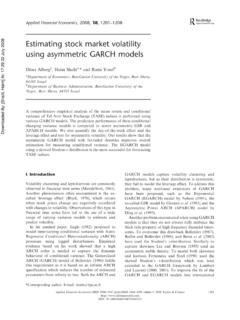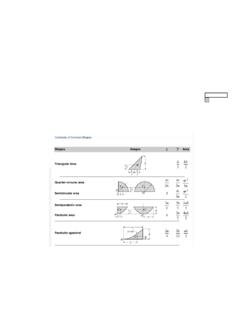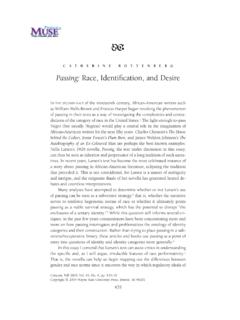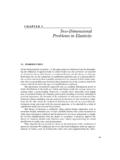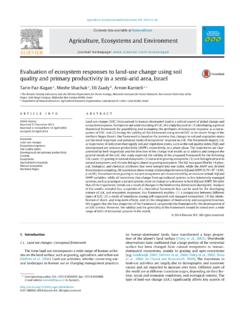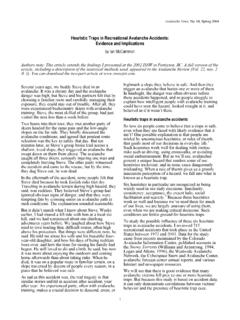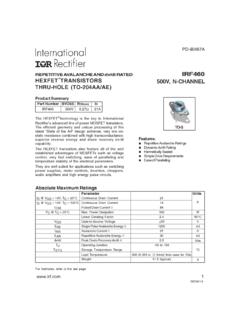Transcription of Avalanche Photodiodes: A User's Guide
1 !"#$%& Avalanche Photodiodes: A User's Guide Abstract Avalanche photodiode detectors have and will continue to be used in many diverse applications such as laser range finders and photon correlation studies. This paper discusses APD structures, critical performance parameters and the excess noise factor. 1. Introduction For low-light detection in the 200 to 1150 nm range, the designer has three basic detector choices - the silicon PIN detector, the silicon Avalanche photodiode (APD) and the photomultiplier tube (PMT). APDs are widely used in instrumentation and aerospace applications, offering a combination of high speed and high sensitivity unmatched by PIN detectors, and quantum efficiencies at > 400 nm unmatched by PMTs. Recently demonstrated performance includes: Noise equivalent power (NEP) of <10-15 W/Hz for a mm APD Detection of 100-photon, 20 ns pulses with standard APDs Detection of 10-photon, 20 ns pulses with special APDs BER data communications at 810 nm at 60 Mb/s with only 39 photons/bit Photon-counting detection efficiencies > 70% at 633 nm; dark counts of only 1 count/s on 150 m diameter APDs Detection and resolution of low energy, 1 to 30 keV X-rays 2.
2 What is an Avalanche photodiode ? APD Structures In order to understand why more than one APD structure exists, it is important to appreciate the design trade-offs that must be accommodated by the APD designer. The ideal APD would have zero dark noise, no excess noise, broad spectral and frequency response, a gain range from 1 to 106 or more, and low cost. More simply, an ideal APD would be a good PIN photodiode with gain! In reality however, this is difficult to achieve because of the need to trade-off conflicting design requirements. What some of these trade-offs are, and how they are optimized in commercially available APDs, are listed below. Consider the schematic cross-section for a typical APD structure shown in Figure 1. The basic structural elements provided by the APD designer include an absorption region A, and a multiplication region M.
3 Present across region A is an electric field E that serves to separate the photo-generated holes and electrons, and sweeps one carrier towards the multiplication region. The multiplication region M is designed to exhibit a high electric field so as to provide internal photo-current gain by impact ionization. This gain region must be broad enough to provide a useful gain, M, of at least 100 for silicon APDs, or 10-40 for germanium or InGaAs APDs. In addition, the multiplying electric field profile must enable effective gain to be achieved at at field strength below the breakdown field of the diode. Figure 1 shows the reach-through structure patented by PerkinElmer which offers the best available combination of high speed, low noise and capacitance and extended red response. Figure 1: Reach-through APD Structure (Not to Scale) Critical Performance Parameters An APD differs from a PIN photodiode by providing internal photo-electronic signal gain.
4 Therefore, output signal current, IS, from and APD equals IS = MRO(l)PS, where RO(l) is the intrinsic responsivity of the APD at a gain M=1 and wavelength l, M is the gain of the APD, and PS is the incident optical power. The gain is a function of the APDs reverse voltage, VR, and will vary with applied bias. A typical gain-voltage curve for a silicon APD manufactured by PerkinElmer is shown in Figure 2. Figure 2: Typical gain-voltage curve for Si APDs One of the key parameters to consider when selecting an APD is the detector's spectral noise. Like other detectors, and APD will normally be operating in one of two noise-limited detection regimes; either detector noise limited at low power levels, or photon shot noise limited at higher powers. As an APD is designed to be operated under a reverse bias, sensitivity at low light levels will be limited by the shot noise and the APDs leakage current.
5 Shot noise derives from the random statistical Poissonian fluctuations of the dark current, ID (or signal current). Dark current or shot noise IN(SHOT) is normally given by IN(SHOT) = (2qBlD) for a PIN detector, where B is the system bandwidth. This differs for an APD however, as bulk leakage current IDB, is multiplied by the gain, M, of the APD(4). Total leakage current ID is therefore equal to: ID = IDS + IDBM Where IDS is the surface leakage current. In addition, the Avalanche process statistics generate current fluctuations, and APD performance is degraded by an excess noise factor (F) compared to a PIN. A detailed explanation and calculation of the excess noise factor, F, is given in section 4. The total spectral noise current for an APD in dark conditions is thus given by: iN = [2q(IDS + IDBM2F)B] Where q is the electron charge.
6 At higher signal light levels, the detector transitions to the photon shot noise limited regime where sensitivity is limited by photon shot noise on the current generated by the optical signal. Total noise from the APD in illuminated conditions will therefore equal the quadratic sum of the detector noise plus the signal shot noise. For a given signal power, PS, this is given by: iN(TOTAL) = [2q(IDS + (IDBM2 + R0(l)M2PS)F)B] In the absence of other noise sources, an APD therefore provides a signal-to-noise ratio (SNR) which is F worse than a PIN detector with the same quantum efficiency. An APD, however, can produce a better overall system signal-to-noise ratio than a PIN detector in cases where the APD internal gain boosts the signal level without dramatically affecting the overall system noise. Noise equivalent power (NEP) cannot be used as the only measure of a detector's relative performance, but rather detector signal-to-noise (SNR) at a specific wavelength and bandwidth should be used to determine the optimum detector type for a given application.
7 Note that optimum signal-to-noise occurs at a gain M where total detector noise equals the input noise of the amplifier or load resistor. The optimum gain depends in part on the excess noise factor, F, of the APD, and ranges from M=100 to 1000 for silicon APDs and is limited to M=30 to 40 for germanium and InGaAs APDs. 3. Selecting an APD Specifying Your Requirement APDs are generally recommended for high bandwidth applications or where internal gain is needed to overcome high pre-amp noise. The following is a simple Guide that can be used to decide whether an APD is the most appropriate for one's light detection requirements. 1. Determine the wavelength range to be covered. See section below to determine the specific APD type useful for the wavelength range to be covered. 2. Determine the minimum size of the detector that can be used in the optical system.
8 Effective optics can often be more cost-effective than the use of an overly large PIN or Avalanche photodiode . 3. Determine the required electrical frequency bandwidth of the system; again, over-specifying bandwidth will degrade the SNR of the system. Types of APDs Avalanche photodiodes are commercially available that span the wavelength range from 300 to 1700 nm. Silicon APDs can be used between 300 to 1100 nm, germanium between 800 and 1600 nm and InGaAs from 900 to 1700 nm. Although significantly more expensive than germanium APDs, InGaAs APDs are typically available with significantly lower noise current, exhibit extended spectral response to 1700 nm, and provide higher frequency bandwidth for a given active area. A germanium APD is recommended for environmental applications in high electro-magnetic interference (EMI), where amplifier noise is significantly higher than the noise from an InGaAs APD, or for applications where cost is primordial consideration.
9 Understanding the Specifications It is important to understand several performance metrics when selecting an APD appropriate for one's application. Listed below are some of the most important specifications, and an explanation as to how different manufacturer's listings should be compared. Responsivity and Gain: APD gain will vary as a function of applied reverse voltage, as shown in Figure 2. In addition, for many APDs, it is not possible, or practical, to make an accurate measurement of the intrinsic responsivity, R0(l), at a gain M=1. It is therefore inappropriate to state typical gain and diode sensitivity at M=1 as a method for specifying diode responsivity at a given operating voltage. In order to characterize APD response, one must specify APD responsivity (in Amps/Watt) at a given operating voltage. However, because of diode to diode variations in the exact gain-voltage curve of each APD, the specific operating voltage for a given responsivity will vary from one APD to another.
10 Manufacturers should therefore specify a voltage range within which a specific responsivity will be achieved. An example of a typically correct specifications for diode responsivity, in this case for an InGaAs APD, is as follows: RMIN(1300 nm) = A/W, VOP = 50V to 90V, M ~ 10 Dark Current and Noise Current: As can be seen from the noise equation in section , total APD dark current (and corresponding spectral noise current) is only meaningful when specified at a given operating gain. Dark current M=1 is dominated by surface current, and may be significantly less than IDB x M. Since APD dark and spectral noise current are a strong function of APD gain, these should be specified at a stated responsivity level. An example of a typically correct specification for diode dark current and noise current, in this case for an InGaAs APD is as follows: ID (R = A/W) = 10 nA (max), M ~ 10 iN (R = A/W), 1 MHz, 1 Hz BW) = (max), M>5 4.

